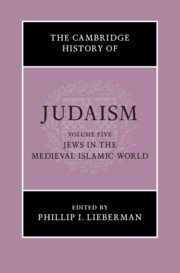Book contents
- The Cambridge History of Judaism
- The Cambridge History of Judaism
- The Cambridge History of Judaism
- Copyright page
- Contents
- Figures
- Acknowledgments
- Introduction
- Part I Jews in the Medieval Islamic World
- A. The Islamic World in the Middle Ages
- Chapter 1 The Sources
- Chapter 2 Jewish Perceptions of and Attitudes toward Islam and Muslims
- Chapter 3 Islamic Attitudes and Policies
- B. Regional Surveys
- Part II Social and Institutional History
- Part III Spiritual and Intellectual History
- Index
- References
Chapter 2 - Jewish Perceptions of and Attitudes toward Islam and Muslims
from A. - The Islamic World in the Middle Ages
Published online by Cambridge University Press: 21 August 2021
- The Cambridge History of Judaism
- The Cambridge History of Judaism
- The Cambridge History of Judaism
- Copyright page
- Contents
- Figures
- Acknowledgments
- Introduction
- Part I Jews in the Medieval Islamic World
- A. The Islamic World in the Middle Ages
- Chapter 1 The Sources
- Chapter 2 Jewish Perceptions of and Attitudes toward Islam and Muslims
- Chapter 3 Islamic Attitudes and Policies
- B. Regional Surveys
- Part II Social and Institutional History
- Part III Spiritual and Intellectual History
- Index
- References
Summary
Jewish perceptions of and attitudes toward Muslims and Islam during the latter’s classical age, when the vast majority of Jews lived in the lands of Islam, were always conditioned by the Jews’ status as a small religious community, widely dispersed yet overrepresented in the major urban centers of Iberia, North Africa, and the Middle East. During the ninth through twelfth centuries (corresponding to the High Middle Ages in Christendom) the Jews of Islam enjoyed full communal autonomy and achieved significant economic prosperity even as a subject minority. Rabbanites and Karaites alike vigorously built new communal institutions and produced singularly important cultural achievements that would transform and rival the inheritance of rabbinic Judaism. However, interpretation of the Jews’ experience under the orbit of classical Islam has been quite varied and is itself historically constructed. In recent years it has been dominated by two fundamentally adverse presentist scholarly paradigms, each with supposed implications for understanding conflict in the modern Middle East.
- Type
- Chapter
- Information
- The Cambridge History of Judaism , pp. 64 - 91Publisher: Cambridge University PressPrint publication year: 2021



